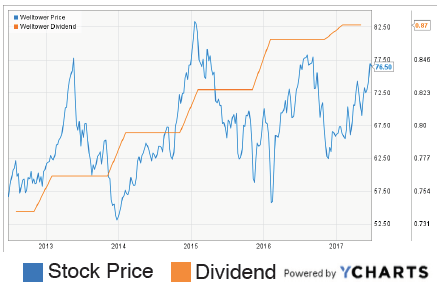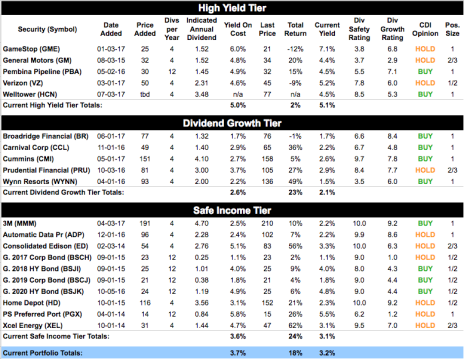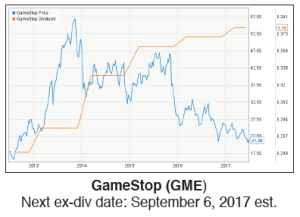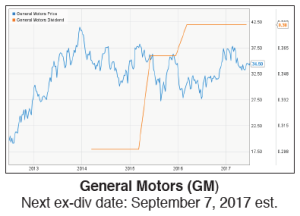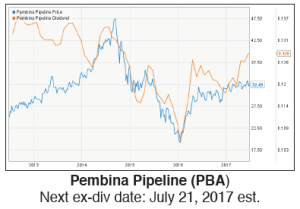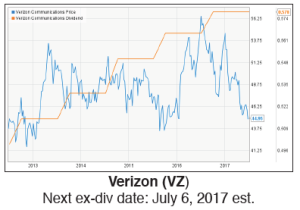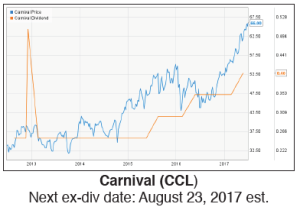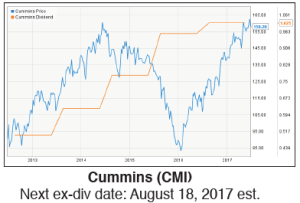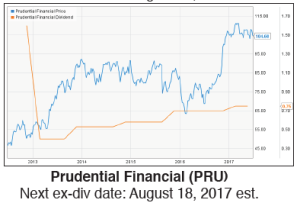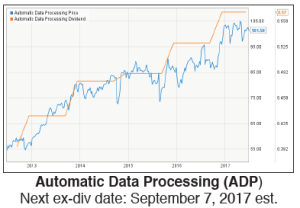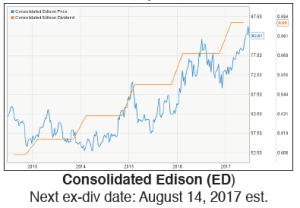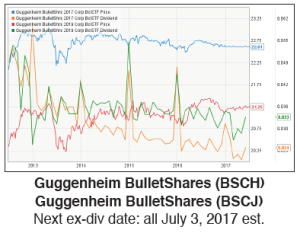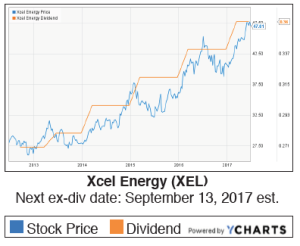This month’s issue includes a new addition to the High Yield Tier, updates on all our holdings, and some advice on handling big winners.
Cabot Dividend Investor 617
[premium_html_toc post_id="135641"]
Rotation
Rotation was the name of the game this month. Tech stocks, which had been leading the market, rolled over early in the month and have struggled to get back on their feet. More conservative sectors, including health care, financials, utilities and real estate, have been vying to become the new leaders. Biotech stocks looked like they might take the crown last week, but suddenly lost their footing yesterday, declining 3.5%. Utilities have also cooled off, and it now looks like it might be financials’ time to shine again, at least for a while. Of course, over the past month, health care stocks have been the number-one performers, as the U.S. Senate debates a new health care bill.
We don’t have any health care exposure in the portfolio, so today I’m adding a very income-focused play on the sector to our High Yield Tier. A health care property REIT, it also gives us some real estate exposure.
[highlight_box]What To Do Now: I’m not making any rating changes in the portfolio today, although Verizon (VZ) has weakened and could be sold soon. On the buy side, Broadridge (BR), Carnival (CCL), and Wynn (WYNN) still look strong, and 3M (MMM), Cummins (CMI) and Pembina (PBA) are offering good buy points. [/highlight_box]
Featured Buy
Welltower (HCN)
This month we’re adding a real estate investment trust (REIT) to the High Yield Tier. With its 4.6% yield, Welltower (HCN) provides steady income plus exposure to one of the fastest-growing segments of the real estate market: health care facilities and senior housing.
The Company
The sixth-largest public U.S. REIT, Welltower owns a large health care-focused real estate portfolio. The company’s 1,400 properties fall into three categories: senior housing, post-acute care centers and outpatient centers.
Welltower’s modus operandi is keeping patients and seniors out of hospitals, where medical care is most expensive. The company’s outpatient centers offer medical procedures that might otherwise be performed in a hospital, like arthroscopic knee surgery. Post-acute care centers provide a non-hospital option for rehab after illness or surgery. And Welltower’s senior housing properties include independent living, assisted living and memory care communities, all designed to keep seniors healthy and keep health care costs down.
The dual trends of the aging U.S. population and the fight to lower health care spending mean Welltower’s properties are thriving. Welltower’s funds from operations (FFO, the best measure of REIT cash flow) have increased in each of the last five years, by an average of about 7% per year.
Of course, Welltower isn’t a charitable organization. The company has positioned itself in a particularly lucrative segment of the health care real estate market, focusing on high-end properties where most patients or residents have private insurance or pay their own way. Many of the company’s senior housing properties are in big cities, where demand is higher and supply lower. In fact, Welltower recently divested several properties in order to focus more tightly on premium, private pay facilities. As a result, FFO/share is expected to decline slightly in 2017, before rebounding in 2018. On the bright side, over 92% of the company’s revenues now come from private payers. And analysts expect revenue growth of about 4% will return in 2018, after a brief stagnation this year.
The Dividend
As a real estate investment trust, or REIT, one of Welltower’s missions is to return excess cash flow to investors. The company has paid dividends consistently since 1992, and has increased the dividend every year since 2010, with increases averaging 3% over the past five years. HCN’s payout ratio is 83%, which doesn’t earn it any points from IRIS, but which is reasonable for a REIT. Altogether, HCN earns a solid Dividend Safety Rating of 8.5, and a middling Dividend Growth Rating of 5.3 (both out of 10).
The biggest appeal here, of course, is the 4.5% current yield. Just be aware that because Welltower is a REIT, the distributions don’t qualify for the lower dividend tax rate.
The Stock
HCN (the stock symbol comes from Welltower’s former name, Health Care REIT) has been stuck in a loose trading range since the beginning of 2013, with lows as low as 55 and highs around 80. The stock’s latest bottom was at 60 in November 2016, just after the U.S. election.
Since the election, health care REITs have outperformed the rest of the real estate sector, as investors concluded that Republicans’ health care proposals would benefit these private companies. HCN has gained 24% since November 10, vs. 9% for the real estate sector (XLRE).
Welltower CEO Tom DeRosa thinks rolling back the Affordable Care Act would hasten the adoption of value-based reimbursement for health care, calling it “perhaps the most compelling opportunity the real estate industry has seen in decades.” But even if Republican’s health care legislation fails, the trend toward value-based reimbursement, and away from the fee-for-service model, is well underway.
To the upside, HCN could face significant resistance around 80, where the stock topped out in 2016, and 83, where it peaked in 2015. However, if it can break through those levels, the sky is the limit. Of course, in the meantime, owners will enjoy the 4.5% yield.
We’ll be adding HCN to the High Yield Tier of our portfolio at the stock’s average price on Monday (the first trading day of July.) High yield investors with moderate risk tolerance and medium- to long-term investing horizons can do the same.
| Welltower (HCN) | ||
|---|---|---|
| Price: 77 52-week range: 59.39-80.19 Market cap: $28.09 billion P/E: 49 | Current yield: 4.6% Annual dividend: $3.48 Most recent dividend: $0.87 Dividend Safety rating: 8.5 Dividend Growth rating: 5.3 | |
| Dividends since: 1992 Consecutive years of increases: 7 Qualified dividends? No | Payment Schedule: Quarterly Next ex-dividend date: August 4, 2017 est. | |
Portfolio at a Glance
Closing Prices on June 27, 2017
Portfolio Updates
High Yield Tier
The investments in our High Yield tier have been chosen for their high current payouts. These ?investments will often be riskier or have less capital appreciation potential than those in our other ?two tiers, but they’re appropriate for investors who want to generate maximum income from their? portfolios right now.
HOLD – GameStop (GME 21 – yield 7.1%) – Last week, I wrote that GME needed to find support above 20 if it was going to keep its place in our portfolio, and that’s just what the stock has done. After bottoming out at 20.5 on Wednesday, GME is bouncing nicely this week. In corporate news, GameStop is selling Kongregate, the mobile game publisher they acquired in 2010. GameStop’s digital segment grew slowly last quarter, only 3%, compared to 39% growth in its collectibles business and 22% growth in its technology brands stores. And digital sales declined by 4% last year, to $181 million, compared to collectibles sales of $494 million (up 60%) and tech brands sales of $814 million (up 52%). The divestment looks like a smart move. If you own GME, you can Hold.
HOLD – General Motors (GM 34 – yield 4.4%) – GM CFO Chuck Stevens held a conference call on Monday to update analysts on the industry and the Opel/Vauxhall sale. While auto sales have slowed this year, Stevens said the largest declines are in areas GM is de-emphasizing, including fleet sales and passenger cars. Truck and SUV sales and pricing remain strong. GM is adjusting appropriately, and maintaining its full-year guidance. The Opel/Vauxhall divestment is expected to have a positive impact in several areas, including improving margins and free cash flow. GM slipped about 1% after the presentation, but remains in a very tight range just above its 50-day moving average. Hold.
BUY – Pembina Pipeline (PBA 32 – yield 4.5%) – Oil prices found support at $42.50 last week, putting an end to energy stocks’ slide. PBA has even managed to bounce a bit, closing higher on each of the last four days. Energy prices are a headwind, but PBA still looks closer to breaking out of its trading range to the upside than to the downside. Risk tolerant high yield investors can buy a little here.
HOLD – Verizon (VZ 45 – yield 5.2%) – VZ could be putting in a double bottom at 45, or it could be starting a new leg down—in which case we’d sell. For now, Hold.
Dividend Growth Tier
To be chosen for the Dividend Growth tier, investments must have a strong history of dividend increases and indicate both good potential for and high prioritization of continued dividend growth.
BUY – Broadridge Financial Solutions (BR 76 – yield 1.7%) – Broadridge is a tech company that makes products and services for the financial industry. The stock started this month with an orderly 4% retreat from its recent all-time high before finding support at 74. After a two-week rebound, it’s now trading around 76, just below its all-time highs. BR is a Buy for dividends and growth.
BUY – Carnival (CCL 65 – yield 2.2%) – Carnival announced second-quarter earnings that beat revenue and earnings expectations last Thursday. Adjusted EPS and revenue both grew about 6%, to $0.52 per share and $3.94 billion. Analysts were expecting the cruise company to report a 4.1% decline in EPS and 4.8% sales growth, to $3.88 billion. Higher sales and operational improvements more than made up for higher fuel prices and worse exchange rates. Cruise ticket prices rose 5%, and bookings for the rest of the year are well ahead of last year. Management raised the low end of their full-year EPS guidance, from $3.50 to $3.60. The high end is still $3.70 per share. If you don’t own CCL yet, this week’s slight pullback looks like a decent buying opportunity; the stock rarely pauses for long.
BUY – Cummins (CMI 158 – yield 2.6%) – Cummins makes engines for trucks, busses, boats and heavy machinery. The stock pulled back from all-time highs last Wednesday, after Deutsche Bank downgraded peer Caterpillar (CAT). The downgrade questioned Trump’s ability to pass an infrastructure spending plan, and argued that North American non-residential construction will slow without one. The pullback looks like a one-day event for now, CMI found support at 158 and has been trading sideways since. If you don’t own CMI yet, I think it’s buyable here.
HOLD – Prudential Financial (PRU 105 – yield 2.9%) – Financials pulled back sharply late last week, but have started to rebound as bond yields rise this week. ECB President Mario Draghi said Tuesday that “the threat of deflation is gone and reflationary forces are at play,” sending Euro and U.S. bond yields higher. PRU remains near the bottom of its six-month trading range. We’ll keep it on Hold.
BUY – Wynn Resorts (WYNN 136 – yield 1.5%) – WYNN hit a new 52-week high just under 140 this week. Visitors, including VIPs, are returning to Macau even more quickly than expected, and the company’s new resort there is getting great reviews. Analysts expect Wynn to achieve 30% sales growth this year, the first full year of operation for the Wynn Palace. The stock is up 57% year-to-date, but still well below its peak from 2014 (when it topped out just below 250). If you own it, hold on tight, but if you don’t, I still think you can buy here. The company’s dividend can rise very quickly when cash flow is growing.
Safe Income Tier
The Safe Income tier of our portfolio holds long-term positions in high-quality stocks and other investments that generate steady income with minimal volatility and low risk. These positions are appropriate for all investors, but are meant to be held for the long term, primarily for income—don’t buy these thinking you’ll double your money in a year.
BUY – 3M (MMM 210 – yield 2.2%) – After hitting a new high early last week, MMM treaded water for a bit, ignoring the weakness in industrials. However, the stock finally pulled back 1.3% during yesterday’s big rotation. The pullback could get a little deeper but looks like a good buying opportunity; 3M has all the hallmarks of a long-term winner, including accelerating revenue growth and rising earnings estimates. If you don’t own it yet, you can buy here.
HOLD – Automatic Data Processing (ADP 102 – yield 2.2%) – ADP retreated slightly over the past week, and is now trading just above its 50-day line. I’m still lukewarm on the stock—the twin gaps down post-earnings in February and May are discouraging—but I’m trying to give it a chance to prove me wrong (plus, we have a small profit cushion to work with). Hold.
HOLD – Consolidated Edison (ED 83– yield 3.3%) – Utilities finally gave up their market-leading position this week. The Utilities SPDR (XLU) declined 1.8% over the past five days, the worst performance of any sector. ED’s retreat looks perfectly normal though, and the stock could find support at its 50-day line, currently at 81. Hold.
HOLD – Guggenheim BulletShares 2017 Corporate Bond ETF (BSCH 23 – yield 1.1%)
BUY – Guggenheim BulletShares 2018 High Yield Corporate Bond ETF (BSJI 25 – yield 4.0%)
BUY – Guggenheim BulletShares 2019 Corporate Bond ETF (BSCJ 21 – yield 1.8%)
BUY – Guggenheim BulletShares 2020 High Yield Corporate Bond ETF (BSJK 25 – yield 4.8%)
These four funds make up our bond ladder, a conservative strategy for owning fixed income that’s particularly good at preserving capital when interest rates are rising, because of the funds’ maturity features. Each ETF will mature at the end of the year in the fund’s name, and Guggenheim will distribute the net asset value (NAV) of the fund to shareholders at that point—just like getting your principal back when a bond matures. Towards the end of each year, we’ll sell that maturing fund and reinvest the proceeds into a new longest-dated ETF to preserve the bond ladder. If you’re looking to start a new bond ladder today, start with the 2018 fund as your nearest-dated position and add a 2021 fund if you’d like to build a four-year ladder. You can use either investment grade funds (which begin BSC) or high yield funds (which begin BSJ) or a mix, like we have. All the funds pay distributions monthly.
HOLD – Home Depot (HD 152 – yield 2.3%) – HD suffered a one-day, 2.7% selloff on Friday. This time, the culprit wasn’t a retail sector selloff but strong housing data—too strong! New home sales hit 610,000 in May, the Commerce Department said Friday, and the median home price hit an all-time high, sparking concerns about affordability. Hold.
HOLD – PowerShares Preferred Portfolio (PGX 15 – yield 5.5%) – PGX is a Hold for investors who want reliable monthly income. The preferred share ETF doesn’t have capital appreciation potential, but it trades in a low-volatility range between 14 and 16 and pays monthly dividends of about seven cents per share.
HOLD – Xcel Energy (XEL 47 – yield 3.1%) – XEL held up pretty well during the utility pullback this week—the stock remains above its 50-day line and just below all-time highs. If you own it, hold on and enjoy the yield.
Dividend Calendar
Ex-Dividend Dates are in RED and italics. Dividend Payments Dates are in GREEN. See the Guide to Cabot Dividend Investor for an explanation of how dates are determined and what estimated dates mean.
How to Handle Big Winners
I’ve heard from a few subscribers recently who want to know if it’s time to sell their big winners, like Wynn (WYNN), which is up 48% since I recommended it in April of last year. My colleague Mike Cintolo, chief analyst of Cabot Growth Investor, has been getting some similar questions, and recently addressed the same issue. While our dividend-focused system is different from Mike’s growth-oriented system, most of his rules will work well for dividend investors. Here are Mike’s guidelines for handling big winners:
First off, there’s no one perfect way to handle big winners; if there was, then nobody would ever get shaken out and everyone would sell at the top. That’s not going to happen! But keeping three facts in mind will help.
The first fact: As a growth investor, grabbing a few big winners is key to your long-term success. That’s because it’s difficult to make much upside progress if you’re taking only 15% or 20% profits; those singles eventually get eaten away by small losses (and the occasional loser that gets away from you on, say, an earnings gap). Growth investing tends to be skewed, with a lot of your net profit coming from a relatively few trades.
Another fact is that even the best winners are going to have a bunch of scary corrections and tedious sideways periods during their advances. You can use almost any example, but look at Baidu (BIDU), which we bought in July 2009 and rode for more than two years. Our total profit was 283%, but during its upmove, BIDU had seven pullbacks of at least 14%. In other words, you’re going to have to take plenty of heat at times.
To chime in, Mike’s second point is even more important for dividend investors, who aim to hold some stocks for years or even decades. Uptrends will alternate with periods of stagnation, and even corrections, like the 10 months of nothing ED delivered in 2016. Investors eventually returned to the stock in December, and ED has gained an additional 21% since then, doubling our profits to 55% (price only).
Here’s Mike’s conclusion:
And the third fact is that big moves take time to play out. For a stock to run 100%, 200% or more, it’s going to take many months if not longer as institutional investors build positions.
Combining all three, we believe that (a) when you catch a tiger by the tail, you want to try to get as much as you can out of it, but (b) you must use a system that gives you conviction and gives the stock room to correct and consolidate along its way higher while also (c) having an idea of where the stock is within its longer-term advance.
That’s why we advise using our “tight-to-loose” system, which means we start out with a relatively tight loss limit but then gradually loosen our mental stop as the stock advances. Ideally, if we have a big enough profit, we like to simply ride the stock’s 200-day moving average, which usually contains most big winners’ major upmoves. We also frequently (though not always) take partial profits on the way up, which not only books some profit but allows us more conviction in giving our remaining shares more rope.
On the flip side, there are a couple of things we don’t advise. One is to sell all your shares on the way up. We like booking profits as much as anyone, but telling a stock it can’t go any higher can prove very painful if you really do have a true market leader.
Mike’s last point may be his most important, for both dividend and growth investors. Selling a winner on the way up is a recipe for regret. That’s why we still own all of Carnival (CCL) and Wynn Resorts (WYNN), which are both still in uptrends, and in which we have 36% and 48% profits (price only). We also still own most of Consolidated Edison (ED) and Xcel Energy (XEL), which have advanced 55% since we bought them, and which we plan to hold for years as part of our Safe Income strategy. Holding on through corrections and sideways periods will be even more important for those stocks. (On the other hand, CCL and WYNN, in the Dividend Growth portfolio, are cyclical, so we’ll treat them more like growth stocks and get out when the time is right.)
For now, though, we’re more than happy to hold all four stocks and collect the dividends.
[premium_html_footer]
Your next issue will be published July 26, 2017
Cabot Wealth Network • 176 North Street • Salem MA 01970 • 978-745-5532
Neither Cabot Wealth Network nor our employees are compensated by the companies whose stocks we recommend. Sources of information are believed to be reliable, but are in no way guaranteed to be complete or without error. Recommendations, opinions or suggestions are given with the understanding that subscribers acting on the information assume all risks. © Cabot Wealth Network. Copying and/or electronic transmission of this report is a violation of U.S. copyright law. For the protection of our subscribers, if copyright laws are violated, the subscription will be terminated. To subscribe or for information on our privacy policy, call 978-745-5532, visit www.cabotwealth.com or write to support@cabotwealth.com.
[/premium_html_footer]

